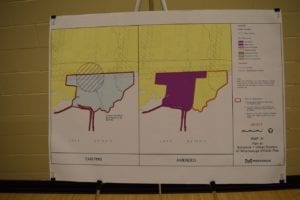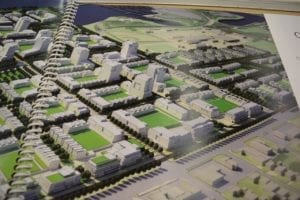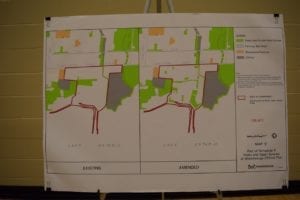Mississauga has a strong track record for civic engagement
I’ve recently posted a link to a Globe and Mail story about positive trends in urban development at the City of Mississauga:
Anecdotes shared by fellow walkers, on Jane’s Walk at Mississauga-Toronto border

Room setup for Nov. 9, 2016 Inspiration Lakeview public consultation. I did not have time to stay for the full meeting as I also attended a public consultation, on Nov. 9, 2016 in Etobicoke, related to public input concerning a recent, Province-wide OMB Review project. Jaan Pill photo
The urban trends, that I refer to, are things that I first began to think about some years ago, in May 2014, on the occasion of a Jane’s Walk at the Toronto-Mississauga border:
Mississauga’s vision
Some previous items, that I’ve been pleased to post at the Preserved Stories website, include:
The “3P” Strategy in Lakeview: Proactive, Persistent, and Positive
Thanks from Jim Tovey for volunteers who made May 28, 2016 Small Arms Jane’s Walk a terrific event
May 3, 2015 Jane’s Walk in Mississauga at Small Arms Building focused on the past, and the future

Also on Nov. 9, 2016, I attended an OMB Review meeting in Etobicoke just east of the Mississauga-Toronto border. I have highlighted the meeting at a post entitled: Culture of COA and OMB decision-making has changed dramatically in 25 years: MPP Peter Milczyn.
Urban planning: Mississauga and Toronto
As a rule, as a blogger I’ve stayed away from generalizations, regarding comparisons between cities. However, it has occurred to me that it would be useful to articulate my thoughts, regarding the distinct urban planning cultures that appear to be at play, in Mississauga as compared to Toronto. Such generalizations are subject to error; I look forward to learning of contrary views, that would persuade me to modify my perspective, regarding some key differences between the two cities.
Comments from Long Branch Development Facebook Page
I’ve shared the following comments at the Long Branch Development Facebook Page, and am pleased to share the comments as a separate Preserved Stories post as well:
I draw inspiration from the fact that, because I live close to the Mississauga-Toronto border, I have the opportunity to compare how development patterns are evolving in the two communities (Mississauga and Toronto).

Image from Inspiration Lakeview public consultation meeting, Nov. 9, 2016 in Mississauga. Jaan Pill photo
As a blogger, I have been writing about development patterns in both cities for several years, reporting on urban planning and public consultation events in each of them. The positive trends that I see in Mississauga make the city a source of inspiration for places around the world, with the exception perhaps of Toronto, which tends to be blinded by arrogance about where to look for inspiration.
I sometimes ponder what historical trends, dating back many years, have given rise to such divergent paths, of the two cities.
Click on photos to enlarge them; click again to enlarge them further
To my previous comment (above) I can add that the divergence, that I describe, is particularly evident with regard to public consultations and the concept of civic engagement. In official communications, both cities peak of the value of civic engagement. The difference arises, however, when we look at the match between the rhetoric and the reality.

Image from Inspiration Lakeview public consultation meeting, Nov. 9, 2016 in Mississauga. Jaan Pill photo
In Mississauga, from what I have closely observed, as a blogger focusing on accuracy and balance in my reporting, the match between the rhetoric and the reality tends to be very close, with the exception, perhaps, of its Police Service. My sense is that Police Services in Toronto and Mississauga are very similar, and demonstrate the same problems, in particular with regard to the distinction between rhetoric and reality, with regard to providing fair and equitable service to all members of the community.
In Toronto, with regard to the public consultation process, the contrast between rhetoric and reality is stark; in practice, the views of residents tend to be disregarded and the residents who speak out, for example at Committee of Adjustment meetings, are routinely denigrated and insulted. I look forward to seeing whether any of the problems, that are evident as long-term trends in Toronto, can be addressed at the Provincial level. A recent post outlining the trends in this area is entitled:
Culture of COA and OMB decision-making has changed dramatically in 25 years: MPP Peter Milczyn

Image from Inspiration Lakeview public consultation meeting, Nov. 9, 2016 in Mississauga. Jaan Pill photo

Image from Inspiration Lakeview public consultation meeting, Nov. 9, 2016 in Mississauga. Jaan Pill photo
A previous post regarding Police Services is entitled:
Peel Regional Police Service has problems similar to what is evident at Toronto Police Service
I can add the following comment, from a previous post regarding differences between Mississauga and Toronto:
The City of Mississauga has a clearly defined Strategic Plan that is – amazing as this may sound – actually developed with broad input from Mississauga residents, and from what I can see (as a blogger, I make a point of observing such things as closely as I can), the Strategic Plan is actually in the process of being implemented.

Image from Inspiration Lakeview public consultation meeting, Nov. 9, 2016 in Mississauga. Jaan Pill photo
As well, the governance and communications structures at the City of Mississauga appear to me to be of the highest quality. In fact, it has been the quality of the communications related to the Lakeview Waterfront Connection Project, the Small Arms Building re-purposing project, the TRCA/Sawmill Sid ash tree repurposing project, Inspiration Lakeview, and similar projects that originally alerted me to the great projects, with a great deal of citizen input, going on right now at the City of Mississauga.
Updates
I’ve discussed these topics further, in a post entitled:
City of Mississauga demonstrates a good sense of scale, in its decision-making processes
A Jan. 1, 2017 Toronto Star article is entitled: “19 years ago, Toronto’s six boroughs amalgamated: 19 years ago today, Toronto’s surrounding communities amalgamated in one of the most controversial moves in Toronto’s municipal government history.”
A Jan. 3, 2017 Toronto Star article is entitled: In 2017, Mississauga will have to decide how it grows up: Mississauga’s recent booming growth will continue, but will growth be sustainable and will it be what residents want?”
A March 29, 2017 City of Mississauga news release is entitled: “City of Mississauga Wins Municipality of the Year Award.”
A May 20, 2017 CBC article entitled: “Google plans to ‘fix’ Toronto by building smart city: Underdeveloped waterfront ideal location to start building smart city.”

The City of Toronto seems to think that development is the answer to its problems and the public are swept aside. In Mississauga the will of the people, the central pillar of democracy, is still followed. The City of Toronto is just too large and needs Community Councils (as was recommended) so that real people can shape the City instead of developers. The election of Rob Ford shows how alienated are Toronto residents. The City has an excellent Chief Planner with great ideas but it is a hard sell to Council as low taxes seem to be a priority. And there is never enough time for full civic engagement like Mississauga’s. That is what is the sticking point to Toronto becoming progressive and engineering a better quality of life. Merry Christmas
Merry Christmas, David. Your work on behalf of the residents in Long Branch is so very much appreciated. I am pleased that we have the example of Mississauga’s approach available to us, as residents of Toronto. Having a basis for comparison is highly valuable, in the circumstances. I recall meeting a former Toronto resident at a public consultation meeting in Mississauga some years ago. She remarked that she was very pleased that she had made the move, from Toronto to Mississauga.
I live close to the Mississauga-Toronto border. That location – living at a borderland, so to speak – offers a person a unique perspective. I’m pleased I’ve had the opportunity, in recent posts, to articulate some things that I have learned, as a borderland observer.
It is also of interest to think about what has led Toronto to its current situation, with regard to civic engagement. My sense is that Amalgamation of the former Buroughs and the former (geographically much smaller) City of Toronto has had much to do with this. There is no sense of cohesiveness and unity of purpose, of the kind that is evident in Mississauga. For civic engagement to function well, my sense is that certain conditions must first be in place. Possibly, such conditions were in place in the former Buroughs, and on the original City of Toronto. I do not know the local histories to be able to say much of value, regarding that topic.
I help out, in terms of civic engagement, in Toronto, to the extent that I can in the circumstances that are available, in this fine city. I also do a lot of volunteer work, with regard to support for civic engagement, in Mississauga. Such work is a strong source of inspiration for me.
When councillors become advocates for developers and their lucrative hi-rise condo schemes, then the residents of Toronto have reason to feel they have been sold out to “the bottom line.” When citizens who foster residents’ participation in planning for holistic community development are rebuffed and demonized, then again the people of Toronto know that democracy has become plutocracy. When “community revitalization and renewal” becomes little more than adding units of housing to already under-serviced areas, then citizens know that their well-being has been sidelined in favour of the narrow focussed westward wave of hi-rise condo intensification and profiteering.
Good to read your comment, Harry. The contrast between the City of Toronto, with regard to the building of high-rise condos on the waterfront, and the City of Mississauga, is very stark. As a recent Globe and Mail article underlines, Mississauga is headed in a direction where Toronto’s past mistakes are not repeated:
Land sale brings Mississauga closer to a waterfront that avoids Toronto’s mistakes – Dec. 22, 2016 Globe and Mail
A key point, as well, is that the contrast between Mississauga and Toronto is not a matter of, say, Preserve or Progress. Instead, both support development – but the Mississauga mode of development ensures that citizen input is respected, and is closely taken into account, whereas in Toronto, the developers tend to be the de facto planners, with everybody else – citizens as well as professional planners – relegated to the sidelines.
It’s a matter of two distinct cultures, which have grown up, matured, over time. Cultures appear hard to change, once they are set into place.
The example of the City of Mississauga underlines the fact that there are choices. The choice that the City of Toronto has made – for example with the congestion of high-rise condos at Humber Bay Shores – and at the downtown Toronto waterfront – is clearly not the only choice, that is available.
Re: Preserve of Progress argument
With regard to the Preserve or Progress topic, by way of example, at the Small Arms Building re-purposing project, at Lakeshore Rd. East and Dixie Road in Mississauga, the choice has been made to Preserve *and* Progress. The building is being transformed, with strong support from citizens and three levels of government. Re-purposing of the building, as a Cultural Hub, speaks to the Progress element, on this occasion.
A successful project of this kind requires input from many sets of skills and qualities – expertise in marketing, event planning, cultural planning, graphic design, project management, and an entrepreneurial spirit, to name a few. Mississauga is showing how such a project can be launched, funded, and publicized.
The building is also being Preserved. In Toronto, a building like the Small Arms Building would long ago have been demolished – either bulldozed, as almost occurred with the Small Arms Building, or relegated to the dustheap in the slow-motion process known as Demolition By Neglect.
Placement of condos
Mississauga is also stepping outside the standard Preserve or Progress scenario with regard to condos. Tall condos have their place, in Mississauga’s future – but not along the waterfront. The waterfront – the view of the water that is accessible to the average citizen out for a stroll – will be Preserved. By way of Progress, meanwhile, the tall condos are going up along the major arterial roadways in Mississauga, away from the waterfront.
What is required, by way of a project such as the Small Arms re-purposing project, and good choices (that take into account the needs of everyday citizens as well as developers and the market economy) by way of condo construction, is the capacity for people to get together, figure things out under conditions of mutual respect, and develop a closely coordinated strategy for development. That is happening in at the City of Mississauga. That is decidedly not happening at the City of Toronto.